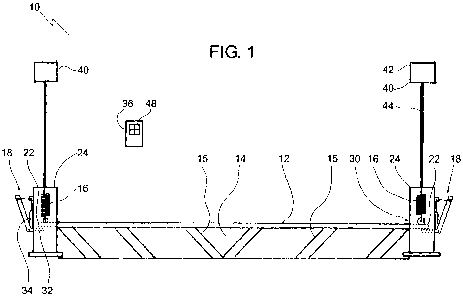Some of the information on this Web page has been provided by external sources. The Government of Canada is not responsible for the accuracy, reliability or currency of the information supplied by external sources. Users wishing to rely upon this information should consult directly with the source of the information. Content provided by external sources is not subject to official languages, privacy and accessibility requirements.
Any discrepancies in the text and image of the Claims and Abstract are due to differing posting times. Text of the Claims and Abstract are posted:
| (12) Patent Application: | (11) CA 2704259 |
|---|---|
| (54) English Title: | PARKING STALL BARRIER |
| (54) French Title: | BARRIERE POUR PLACE DE STATIONNEMENT |
| Status: | Deemed Abandoned and Beyond the Period of Reinstatement - Pending Response to Notice of Disregarded Communication |
| (51) International Patent Classification (IPC): |
|
|---|---|
| (72) Inventors : |
|
| (73) Owners : |
|
| (71) Applicants : |
|
| (74) Agent: | NATHAN V. WOODRUFFWOODRUFF, NATHAN V. |
| (74) Associate agent: | |
| (45) Issued: | |
| (86) PCT Filing Date: | 2008-10-24 |
| (87) Open to Public Inspection: | 2009-05-07 |
| Availability of licence: | N/A |
| Dedicated to the Public: | N/A |
| (25) Language of filing: | English |
| Patent Cooperation Treaty (PCT): | Yes |
|---|---|
| (86) PCT Filing Number: | PCT/CA2008/001883 |
| (87) International Publication Number: | WO 2009055905 |
| (85) National Entry: | 2010-04-30 |
| (30) Application Priority Data: | ||||||
|---|---|---|---|---|---|---|
|
A parking stall barrier includes an elongated horizontal member and a pair of
supports. The pair of supports are
positioned in spaced relation and support the opposed ends of the horizontal
member. The horizontal member is movable vertically
along the supports between a raised barrier position and a lowered access
position. A locking latch mechanism secures the horizontal
member in the raised barrier position. When the locking latch mechanism is
released, the horizontal member can be moved from the
raised barrier position to the lowered access position to facilitate vehicle
ingress and egress.
L'invention concerne une barrière pour place de stationnement comprenant un élément horizontal allongé et une paire de supports. Les deux supports sont disposés de manière espacée et ils supportent les extrémités opposées de l'élément horizontal. Ledit élément horizontal peut être déplacé verticalement le long des supports, entre une position de barrière haute et une position de passage basse. Un mécanisme de verrouillage fixe l'élément horizontal dans la position de barrière haute. Lorsque le mécanisme verrouillage est libéré, l'élément horizontal peut être déplacé de la position de barrière haute à la position de passage basse pour permettre l'entrée et la sortie d'un véhicule.
Note: Claims are shown in the official language in which they were submitted.
Note: Descriptions are shown in the official language in which they were submitted.

2024-08-01:As part of the Next Generation Patents (NGP) transition, the Canadian Patents Database (CPD) now contains a more detailed Event History, which replicates the Event Log of our new back-office solution.
Please note that "Inactive:" events refers to events no longer in use in our new back-office solution.
For a clearer understanding of the status of the application/patent presented on this page, the site Disclaimer , as well as the definitions for Patent , Event History , Maintenance Fee and Payment History should be consulted.
| Description | Date |
|---|---|
| Application Not Reinstated by Deadline | 2011-10-24 |
| Time Limit for Reversal Expired | 2011-10-24 |
| Inactive: Office letter | 2011-04-27 |
| Inactive: Office letter | 2011-04-27 |
| Deemed Abandoned - Failure to Respond to Maintenance Fee Notice | 2010-10-25 |
| Inactive: Cover page published | 2010-07-05 |
| Correct Inventor Requirements Determined Compliant | 2010-06-24 |
| Inactive: Inventor deleted | 2010-06-24 |
| Inactive: Inventor deleted | 2010-06-24 |
| Inactive: Notice - National entry - No RFE | 2010-06-24 |
| Inactive: First IPC assigned | 2010-06-15 |
| Inactive: IPC assigned | 2010-06-15 |
| Inactive: IPC assigned | 2010-06-15 |
| Application Received - PCT | 2010-06-15 |
| Small Entity Declaration Determined Compliant | 2010-04-30 |
| National Entry Requirements Determined Compliant | 2010-04-30 |
| Application Published (Open to Public Inspection) | 2009-05-07 |
| Abandonment Date | Reason | Reinstatement Date |
|---|---|---|
| 2010-10-25 |
| Fee Type | Anniversary Year | Due Date | Paid Date |
|---|---|---|---|
| Basic national fee - small | 2010-04-30 |
Note: Records showing the ownership history in alphabetical order.
| Current Owners on Record |
|---|
| WAYNE GOODMAN |
| VINCENT E. HOUSE |
| Past Owners on Record |
|---|
| None |